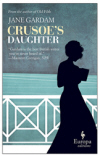Crusoe’s Daughter
Jane Gardam’s magnificent novel Crusoe’s Daughter, first published in 1985 in England and only now published in the U.S., was Gardam’s favorite of her novels: “Take it or leave it, Crusoe’s Daughter says everything I have to say.” Those familiar with the books of this largely unknown, very British novelist will recognize aspects of Gardam’s writing later echoed in Old Filth, The Man With the Wooden Hat and the more recently published God on the Rocks: the wonderfully odd characters sometimes reminiscent of Dickens; the humor; an era’s precise, tiny details of place and people; and indirectly given information, often about past forbidden romances.
Jane Gardam’s magnificent novel Crusoe’s Daughter, first published in 1985 in England and only now published in the U.S., was Gardam’s favorite of her novels: “Take it or leave it, Crusoe’s Daughter says everything I have to say.” Those familiar with the books of this largely unknown, very British novelist will recognize aspects of Gardam’s writing later echoed in Old Filth, The Man With the Wooden Hat and the more recently published God on the Rocks: the wonderfully odd characters sometimes reminiscent of Dickens; the humor; an era’s precise, tiny details of place and people; and indirectly given information, often about past forbidden romances.
This novel meant more to Gardam because it is based on her mother, family, and early childhood home:
It was the elf-light of childhood that still hung about, the wonder of the marsh. The people still more real to me in the vanished place than most of the people I’ve met since.
Suppose I had stayed there—like my mother. Let me suppose a sort of castaway girl who lived there all her life like Robinson Crusoe. I’d give her a library—her dead grandfather’s vicarage books. I’d give her a wonderful lover. I’d give her a nervous breakdown when he is taken from her. I’d give her alcoholism (my mother never drank!). I’d give her children and knowledge of the holiness of the heart’s affections. And I’d show the power of her childhood landscape, the enfolding murmuring magical marsh so flooded with light, sunshine, silvery rain and mist, and the running sea. When I had finished I needn’t write any more books.
Fortunately, she did continue writing, but here, as elsewhere, her nineteenth century characters are real—not romanticized—people: “as I knew they had been . . . starved of money, employment, sex, and the love of men who were not their ‘class.’”
Eleven-year-old Polly Flint comes to her aunts’ north England yellow house, facing the sea and the marshes, because her father is always at sea and her mother dead. From gentle Aunt Frances and bleak Aunt Mary, she overhears an unhappy truth about her mother, but other events have more consequences: their maid Charlotte’s parting curse on her aunts, Aunt Frances’s marriage (which at age 40 signals proof of the desperation of women to marry), and Polly’s visit to Thwaite House and its artsy guests with her generous but eccentric host Mr. Thwaite. These guests seem Dickensian, like “the funny little painter who snaps at the air like a dog,” but this “snapping painter” steps beyond any characterization in capturing the truth about Polly:
“A young woman on the threshold of life . . . the doomed traveler.” And looking at him I saw what a miserable, smug, self righteous lump I was . . . . Seeing all, he had forgiven all, and had shown that, though I was young and stupid, there was some sort of hope.
The housekeeper after Charlotte, Alice, saves Polly, who has become increasingly isolated in the yellow house. From her losses of childhood friends and loves, Polly follows in Robinson Crusoe’s footprints, though without his self-recognition. Instead of going mad with solitude, Crusoe shows resilience and “most extraordinary and unnatural steadiness,” courage and “beautiful self-assurance, his wonderful survival after disaster,” unselfishness, powers of decision, and “sensible sexlessness.”
Only when she is forced out into the world does Polly learn about her family. Typically, such information comes in Gardam’s works indirectly, but here, Polly receives it directly, albeit late. Indirection is still to be found in big events taking place off stage, like WWI and the beginnings of WWII. Yet Polly’s limited life is not at the expense of the precise reproduction of an era. Tiny details bring a scene to life:
Their boots left pools about the patches of linoleum which were so sparse on the cold slabs that the floor seemed to be occasionally painted with dim flowers and leaves and squirls and bare in patches like the traces of an antique pavement.
And indirection also comes with one of Gardam’s favorite devices (also used in Old Filth)—a switch to pages out of a play. Crusoe addresses an eighty-seven-year-old Polly concerning her obsession about him:
Polly Flint: You have been my great love.
Crusoe: That was your misfortune . . .
Characters in fiction cannot make new departures. We are eunuchs.
Frozen eunuchs . . .
Still half in love with books. Is it enough? . . . As a life, not bad.
Marooned of course. But there’s something to be said for islands.
This play form also is an efficient way to find out what’s happened up to the end and how the past has come back to Polly, plus how inadequate this outside view of her is.
This self-acclaimed best novel might be the perfect way into Gardam’s wonderful world.





